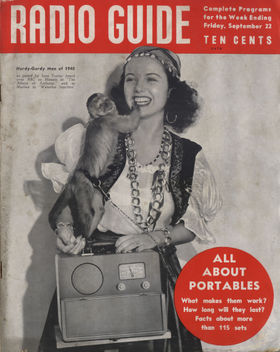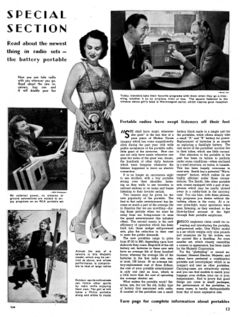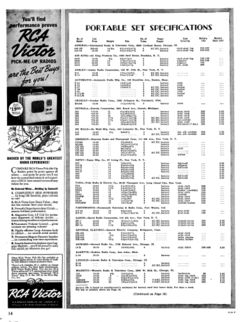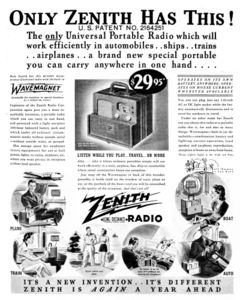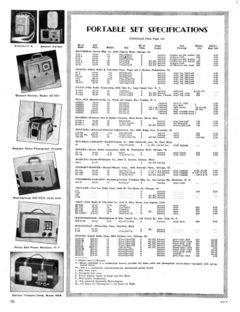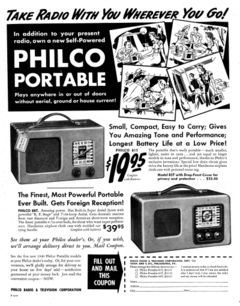Portable Radio Guide, from 1939 Radio Guide
Article Text
"She shall have music wherever she goes" is the last line of a pure piece of Mother Goose imagery which has come magnificently alive during the past year with wide public acceptable of the portable radio, little giant of the airwaves. Now one can not only have music wherever one goes but news of the great war, drama, the hundreds of other daily features which were foregone whenever the listener happened to leave an electric connection.
It is no longer an uncommon sight to see strollers, with a tiny portable strung over their shoulder, listening as they walk; to see travelers in railroad stations or on trains and buses listening to their favorite serials.
Two reasons may be given for the new popularity of the portable. The first is that radio entertainment has become so much a part of the average life in America that we are unwilling -- during those periods when we must be away from our living-rooms -- to miss the grand entertainment this industry offers. The second reason is the new efficiency of operation which has been built into these midget self-powered sets, plus the reduction in their cost to meet public demands.
The new portables range in price from $7.50 to $80, depending upon how elaborate they come. Stepchild of the old battery set, batteries in these new sets have an average life of three hundred hours, whereas the average life of the batteries in the first radio sets was, at mist, 100 hours. At an average battery-replacement cost of three dollars, the cost of your portable entertainment is only one cent an hour, which is a little more than the cost of operating the average electric set.
What makes the portable work? Batteries, yes, but not the old, bulky type of battery first associated with radio. A number of the portables use a small battery block made in a single unit for these portables, while others simply take a small "A" and "B" battery for power. Replacement of batteries is as simple as replacing a flashlight battery. The real secret of the portables' success lies in their tubes, which use little current.
One objection to the portable in the past has been the failure to perform under some conditions -- when enclosed in a steel structure, on trains, in tunnels. This has been largely overcome in most sets. Zenith has a patented "Wavemagnet" feature, which makes its set highly efficient under these circumstances. The Zenith, like other portable sets, comes equipped with a parit of earphones which may be neatly stowed away in a cubby-hole in the carrying-case. you may hear, with these phones, any programs you desire without disturbing others in the room. At a recent prize-fight, many spectators were seen listening, as they watched, to the blow-by-blow account off the fight through portable earphones.
Philco engineers claim credit for inventing and introducing the portable, self-powered radio. One Philco model is a set which weighs only nine pounds and measures six by ten inches, can be carried like a handbag [sic]. An even smaller set, which closely resembles a camera in appearance, has been made by the Majestic Corporation.
For the "platterbug" or record enthusiast, General Electric, Majestic, and others have perfected a combination portable and record-player which is as compact and neat as other portables. Carrying-cases are attractively styled, and you can find models to match your luggage, your clothes, your car or your temperament. And to prove that good things come in small packages, the performance of the portables, in many cases, is hardly distinguishable from that of more expensive sets.
